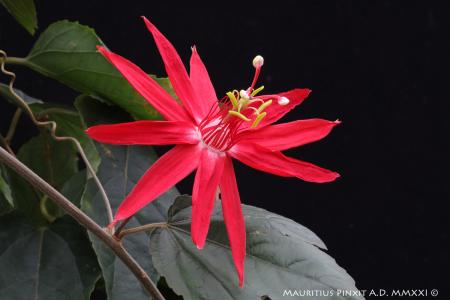
SUBGENUS: passiflora
SUPERSECTION: coccinea
SECTION:
GEOGRAPHICAL DISTRIBUTION OR ORIGIN:
This species is widespread in the forests of South America: Brazil, Colombia, Venezuela, Peru, Bolivia, Guyane, etc.
MINIMUM TEMPERATURE: 10 °C
IDEAL MINIMUM TEMPERATURE: 12 °C
SYNONYMS: Karst.P. servitensisJ. E. Sm., P. sanguinea n,óz & PavÍ (DC.) RuP. punicea
ETYMOLOGY: Leaves similar to that of the common vine (Vitis vinifera, Vitaceae)
NOTES: Chromosomes: n=9, 2n=18
DESCRIPTION:
Passionflowers belonging to the supersection Distephana have chosen bright red to colour their flowers. It is almost always a perfect and very pure red, like that of P. coccinea, P. miniata and others. In this species, the scarlet colour is further enhanced by a large corolla. This spectacular and exciting plant is one of the easiest to grow.
Reproduced from cuttings, it blooms generously even when still small. It lends itself to being used as a houseplant and produces good-tasting decorative fruits. I think it represents, in an exemplary way, the flamboyant exotic and tropical flora.
The forests of the region from Venezuela to Peru are its homeland.
P. vitifolia is pubescent in almost its entirety: stems, leaves, bracts, etc.; the stems and new leaves are bronze or ochre. The trilobate leaves are large, about 17 x 18 cm, with serrated edges. In shape, they call to mind vine leaves, although of a more robust and almost leathery texture. A pair of asymmetrical leaf glands sits at the base of the petiole.
The flower, still in bud, is covered with three bright ochre-coloured bracts with red veins. Upon blooming, sepals and petals of an intense bright red appear, which after a few hours, almost completely retroflect. The sepals have a pointed apex with a green spike at the end. The corona consists of three series of very short filaments (15 mm in length) in relation to the size of the flower (about 18-20 cm). The outermost series is red, while the internal ones are white. The androgynophore column, the filaments of the anthers and the styles are also red.
The fruit, with a diameter of about 5 cm, is light green with elegant white dots placed along the meridians.
Its cultivation, due to its limited hardiness (minimum winter temperature: 10-12°C), is to be done in pots, using rich, well-fertilised soil. In summer, to better enhance its beauty, I recommend letting this creeper grow along wires stretched across the external walls of the house, placing the pot at the base of the wall.
Propagation
from cuttings is easy to achieve and preferable to reproduction by seed, as it
ensures ready flowering plants
TIMELAPSE: